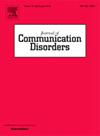与日本学龄前和学龄期口吃儿童口吃样不流利现象相关的语言因素。
IF 2.1
3区 医学
Q2 AUDIOLOGY & SPEECH-LANGUAGE PATHOLOGY
引用次数: 0
摘要
简介口吃受不同语言因素的影响,如句子和单词层面的因素。然而,其发展差异仍不明确。因此,本研究调查了日本学龄前和学龄期口吃儿童中与口吃样障碍(SLD)相关的语言因素的发展差异:我们分析了 30 名 5-10 岁日语口吃儿童的口语。根据年龄将参与者分为三组(5-6 岁、7-8 岁和 9-10 岁):各年龄组的句子长度、文集长度、音节重量和双音频率对 SLD 频率都有显著影响。相比之下,语素频率对 SLD 频率没有显著影响:结论:句子和词语层面的因素都会影响 5-10 岁口吃儿童的 SLD。今后的研究应针对 5 岁以下的儿童,以观察影响口吃的语言因素的详细发育差异。本文章由计算机程序翻译,如有差异,请以英文原文为准。
Linguistic factors associated with stuttering-like disfluencies in Japanese preschool and school-aged children who stutter
Introduction
Stuttering is influenced by different linguistic factors, such as sentence- and word-level factors. However, its developmental differences remain unclear. Thus, this study examined the developmental differences in the linguistic factors associated with stuttering-like disfluencies (SLD) among Japanese preschool and school-aged children who stutter.
Methods
We analyzed utterances from 30 Japanese-speaking children who stutter aged 5–10 years. Participants were divided into three groups according to their age (5–6, 7–8, and 9–10 years old).
Results
Significant effects of sentence length, bunsetsu length, syllable weight, and bi-mora frequency on SLD frequency were observed across the age groups. In contrast, there was not a significant effect of mora frequency on SLD frequency.
Conclusions
Both sentence- and word-level factors affected SLD in children who stutter aged 5–10 years. Future research should be conducted with children below 5 years of age to observe detailed developmental differences in the linguistic factors that affect stuttering.
求助全文
通过发布文献求助,成功后即可免费获取论文全文。
去求助
来源期刊

Journal of Communication Disorders
AUDIOLOGY & SPEECH-LANGUAGE PATHOLOGY-REHABILITATION
CiteScore
3.30
自引率
5.90%
发文量
71
审稿时长
>12 weeks
期刊介绍:
The Journal of Communication Disorders publishes original articles on topics related to disorders of speech, language and hearing. Authors are encouraged to submit reports of experimental or descriptive investigations (research articles), review articles, tutorials or discussion papers, or letters to the editor ("short communications"). Please note that we do not accept case studies unless they conform to the principles of single-subject experimental design. Special issues are published periodically on timely and clinically relevant topics.
 求助内容:
求助内容: 应助结果提醒方式:
应助结果提醒方式:


